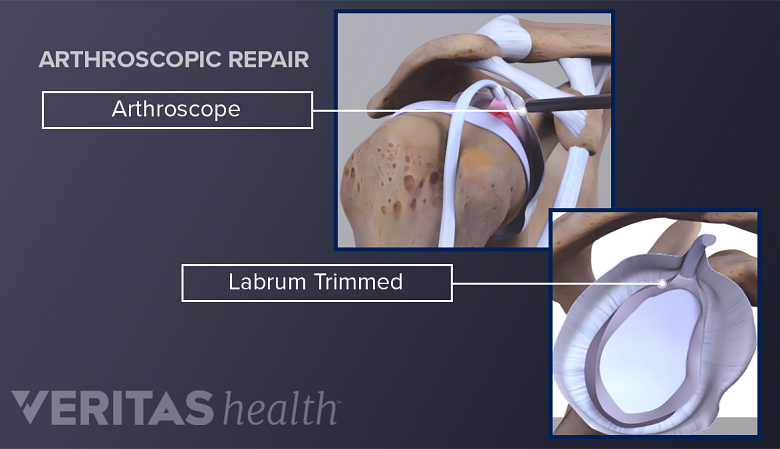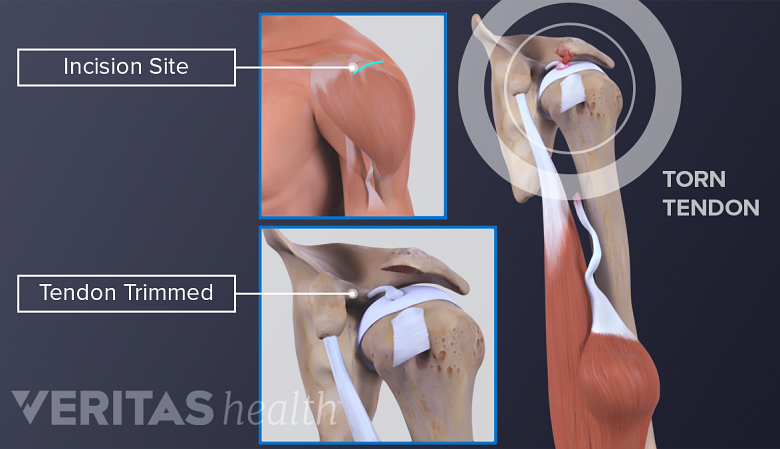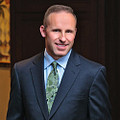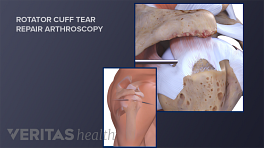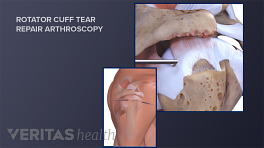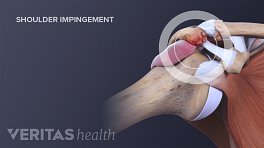Surgical repair of the shoulder’s labrum is recommended when:
- Non-surgical interventions fail to improve shoulder function or reduce pain for over 3 to 6 months 1 LeVasseur MR, Mancini MR, Hawthorne BC, Romeo AA, Calvo E, Mazzocca AD. SLAP tears and return to sport and work: current concepts. J ISAKOS. 2021;6(4):204-211. doi:10.1136/jisakos-2020-000537
- Superior labral anterior to posterior (SLAP) injuries involve a complete detachment of the labrum from the shoulder’s socket (glenoid cavity) 2 Schrøder CP, Skare O, Gjengedal E, Uppheim G, Reikerås O, Brox JI. Long-term results after SLAP repair: a 5-year follow-up study of 107 patients with comparison of patients aged over and under 40 years. Arthroscopy. 2012;28(11):1601-1607. doi:10.1016/j.arthro.2012.02.025
Athletes or manual laborers regularly engaged in activities involving overhead arm movements are more likely to require surgical treatment than non-athletes. 1 LeVasseur MR, Mancini MR, Hawthorne BC, Romeo AA, Calvo E, Mazzocca AD. SLAP tears and return to sport and work: current concepts. J ISAKOS. 2021;6(4):204-211. doi:10.1136/jisakos-2020-000537
Type II SLAP tears, involving the detachment of the labrum from the shoulder socket, are the most common type of SLAP lesion, and most SLAP surgeries involve the treatment of this type of labrum tear. 2 Schrøder CP, Skare O, Gjengedal E, Uppheim G, Reikerås O, Brox JI. Long-term results after SLAP repair: a 5-year follow-up study of 107 patients with comparison of patients aged over and under 40 years. Arthroscopy. 2012;28(11):1601-1607. doi:10.1016/j.arthro.2012.02.025 , 3 Provencher MT, McCormick F, Dewing C, McIntire S, Solomon D. A prospective analysis of 179 type 2 superior labrum anterior and posterior repairs: outcomes and factors associated with success and failure. Am J Sports Med. 2013;41(4):880-886. doi:10.1177/0363546513477363
In This Article:
- SLAP Tear Shoulder Injury and Treatment
- SLAP Tear Symptoms
- Labrum Tear Treatments
- Surgery for SLAP Tear Injury
Types of Surgeries for Shoulder Labrum Tears
SLAP injuries are treated with minimally invasive arthroscopy called labrum debridement.
The degree and type of labrum injury dictate the type of surgery needed for SLAP lesions.
If there are associated rotator cuff lesions, treating those lesions is sometimes sufficient to resolve the symptoms of shoulder pain and stiffness. 4 Provencher MT, McCormick F, Dewing C, McIntire S, Solomon D. A prospective analysis of 179 type 2 superior labrum anterior and posterior repairs: outcomes and factors associated with success and failure. Am J Sports Med. 2013;41(4):880-886. doi:10.1177/0363546513477363
Debridement
SLAP injuries involving fraying of the labrum without detachment, also called type I injury, are treated with minimally invasive surgery (arthroscopy), known as labrum debridement. 5 Brockmeyer M, Tompkins M, Kohn DM, Lorbach O. SLAP lesions: a treatment algorithm. Knee Surg Sports Traumatol Arthrosc. 2016;24(2):447-455. doi:10.1007/s00167-015-3966-0
In this surgery, the frayed labrum is smoothened to prevent further tearing. 1 LeVasseur MR, Mancini MR, Hawthorne BC, Romeo AA, Calvo E, Mazzocca AD. SLAP tears and return to sport and work: current concepts. J ISAKOS. 2021;6(4):204-211. doi:10.1136/jisakos-2020-000537
SLAP repair
Type II and type IV SLAP tears are commonly treated using SLAP repair. 2 Schrøder CP, Skare O, Gjengedal E, Uppheim G, Reikerås O, Brox JI. Long-term results after SLAP repair: a 5-year follow-up study of 107 patients with comparison of patients aged over and under 40 years. Arthroscopy. 2012;28(11):1601-1607. doi:10.1016/j.arthro.2012.02.025 Type II SLAP tears involve the detachment of the labrum without a tear in the labrum, while type IV tears involve a detachment of the labrum along with a tear in the biceps tendon.
A SLAP repair surgery is a minimally invasive procedure where the labrum is reattached to the shoulder joint socket (glenoid cavity) using staples or sutures. 3 Provencher MT, McCormick F, Dewing C, McIntire S, Solomon D. A prospective analysis of 179 type 2 superior labrum anterior and posterior repairs: outcomes and factors associated with success and failure. Am J Sports Med. 2013;41(4):880-886. doi:10.1177/0363546513477363
SLAP repair is the preferred surgery for acute labrum injuries and younger patients under the age of 35 years. 6 Civan O, Bilsel K, Kapicioglu M, Ozenci AM. Repair versus biceps tenodesis for the slap tears: A systematic review. J Orthop Surg (Hong Kong). 2021;29(2):23094990211004794. doi:10.1177/23094990211004794
Biceps tenodesis
Surgical repair of the labrum involves reattaching the cartilage to the shoulder joint socket.
Similar to SLAP repair, biceps tenodesis is indicated when the labrum and biceps tendon tear and/or detach from the shoulder socket (type II and type IV injuries). A failed SLAP repair surgery is also treated with biceps tenodesis.
In biceps tenodesis, the biceps tendon is detached from the labrum cartilage and surgically attached to the upper arm bone (humerus) using a tendon anchor. Both open surgery and minimally invasive techniques are used for biceps tenodesis.
Potential Side Effects and Complications of SLAP Surgery
As with any surgical procedure, there is a potential risk of adverse events and complications associated with SLAP tear surgery. Common side effects include:
- Shoulder pain
- Soreness
- Stiffness
- Instability
These side effects usually improve over time with physical therapy and exercise. 7 Matsuki K, Sugaya H. Complications after arthroscopic labral repair for shoulder instability. Curr Rev Musculoskelet Med. 2015;8(1):53-58. doi:10.1007/s12178-014-9248-5
Severe shoulder stiffness is the most prevalent complication of SLAP surgery and is observed in less than 5% of individuals treated with either SLAP repair or biceps tenodesis. 8 Cvetanovich GL, Gowd AK, Agarwalla A, Forsythe B, Romeo AA, Verma NN. Trends in the Management of Isolated SLAP Tears in the United States. Orthop J Sports Med. 2019;7(3):2325967119833997. Published 2019 Mar 22. doi:10.1177/2325967119833997
In rare cases, severe pain, damage to blood vessels and nerves, and/or infection may occur. 4 Provencher MT, McCormick F, Dewing C, McIntire S, Solomon D. A prospective analysis of 179 type 2 superior labrum anterior and posterior repairs: outcomes and factors associated with success and failure. Am J Sports Med. 2013;41(4):880-886. doi:10.1177/0363546513477363
Success Rates of SLAP Tear Surgery
Surgical repair of the labrum, commonly indicated in type II SLAP tears, has success rates ranging from 71% to 97%. 4 Provencher MT, McCormick F, Dewing C, McIntire S, Solomon D. A prospective analysis of 179 type 2 superior labrum anterior and posterior repairs: outcomes and factors associated with success and failure. Am J Sports Med. 2013;41(4):880-886. doi:10.1177/0363546513477363 , 5 Brockmeyer M, Tompkins M, Kohn DM, Lorbach O. SLAP lesions: a treatment algorithm. Knee Surg Sports Traumatol Arthrosc. 2016;24(2):447-455. doi:10.1007/s00167-015-3966-0
Around 2% to 10% of individuals who undergo SLAP tear surgery experience post-surgical pain and stiffness, necessitating a revision surgery. 9 Nadeem IM, Vancolen S, Horner NS, Leroux T, Alolabi B, Khan M. Management of Failed SLAP Repair: A Systematic Review. HSS J. 2020;16(3):261-271. doi:10.1007/s11420-019-09700-3
An increased risk of requiring revision surgery exists in individuals with obesity, female gender, age over 40, and concurrent biceps tendon tears along with the SLAP injury. 8 Cvetanovich GL, Gowd AK, Agarwalla A, Forsythe B, Romeo AA, Verma NN. Trends in the Management of Isolated SLAP Tears in the United States. Orthop J Sports Med. 2019;7(3):2325967119833997. Published 2019 Mar 22. doi:10.1177/2325967119833997
Recovery after SLAP Tear Surgery
While surgical procedures for labrum tears vary—depending on the type and severity of the tear—there are a few broad post-surgical management guidelines to keep in mind 10 LeVasseur MR, Mancini MR, Hawthorne BC, Romeo AA, Calvo E, Mazzocca AD. SLAP tears and return to sport and work: current concepts. J ISAKOS. 2021;6(4):204-211. doi:10.1136/jisakos-2020-000537 :
| Recovery Timeline after SLAP Surgery | Recovery Guidelines |
|---|---|
| 2-4 weeks after surgery |
|
| 3-6 weeks after surgery |
|
| 6-12 weeks after surgery |
|
| 3 months after surgery |
|
| 4-6 months after surgery |
|
| 8-9 months after surgery |
|
It is advisable to follow the instructions provided by the orthopedic surgeon and physical therapist during the post-surgery recovery phase. Returning prematurely to activities that strain the surgically repaired shoulder, particularly overhead movements, increases the risk of surgical failure.
Patients should discuss the potential benefits, risks, and surgical alternatives with the surgeon before opting for surgery.
- 1 LeVasseur MR, Mancini MR, Hawthorne BC, Romeo AA, Calvo E, Mazzocca AD. SLAP tears and return to sport and work: current concepts. J ISAKOS. 2021;6(4):204-211. doi:10.1136/jisakos-2020-000537
- 2 Schrøder CP, Skare O, Gjengedal E, Uppheim G, Reikerås O, Brox JI. Long-term results after SLAP repair: a 5-year follow-up study of 107 patients with comparison of patients aged over and under 40 years. Arthroscopy. 2012;28(11):1601-1607. doi:10.1016/j.arthro.2012.02.025
- 3 Provencher MT, McCormick F, Dewing C, McIntire S, Solomon D. A prospective analysis of 179 type 2 superior labrum anterior and posterior repairs: outcomes and factors associated with success and failure. Am J Sports Med. 2013;41(4):880-886. doi:10.1177/0363546513477363
- 4 Provencher MT, McCormick F, Dewing C, McIntire S, Solomon D. A prospective analysis of 179 type 2 superior labrum anterior and posterior repairs: outcomes and factors associated with success and failure. Am J Sports Med. 2013;41(4):880-886. doi:10.1177/0363546513477363
- 5 Brockmeyer M, Tompkins M, Kohn DM, Lorbach O. SLAP lesions: a treatment algorithm. Knee Surg Sports Traumatol Arthrosc. 2016;24(2):447-455. doi:10.1007/s00167-015-3966-0
- 6 Civan O, Bilsel K, Kapicioglu M, Ozenci AM. Repair versus biceps tenodesis for the slap tears: A systematic review. J Orthop Surg (Hong Kong). 2021;29(2):23094990211004794. doi:10.1177/23094990211004794
- 7 Matsuki K, Sugaya H. Complications after arthroscopic labral repair for shoulder instability. Curr Rev Musculoskelet Med. 2015;8(1):53-58. doi:10.1007/s12178-014-9248-5
- 8 Cvetanovich GL, Gowd AK, Agarwalla A, Forsythe B, Romeo AA, Verma NN. Trends in the Management of Isolated SLAP Tears in the United States. Orthop J Sports Med. 2019;7(3):2325967119833997. Published 2019 Mar 22. doi:10.1177/2325967119833997
- 9 Nadeem IM, Vancolen S, Horner NS, Leroux T, Alolabi B, Khan M. Management of Failed SLAP Repair: A Systematic Review. HSS J. 2020;16(3):261-271. doi:10.1007/s11420-019-09700-3
- 10 LeVasseur MR, Mancini MR, Hawthorne BC, Romeo AA, Calvo E, Mazzocca AD. SLAP tears and return to sport and work: current concepts. J ISAKOS. 2021;6(4):204-211. doi:10.1136/jisakos-2020-000537
